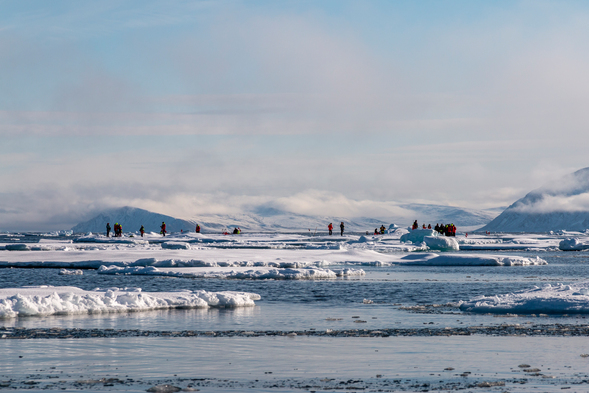Greenland's inhospitable Arctic terrain means that overland travel is impossible on any meaningful level, with boats or planes the only option, so a small ship expedition cruise is the ideal way to explore this fascinating land. At the same time, Greenland is surprisingly accessible as a cruise destination, with direct flights from Reykjavik and Copenhagen, and some itineraries even sail from the UK all the way to Greenland, often as part of a transatlantic crossing to Canada and the US.

Generally when we talk about Arctic cruises our top recommendation is the Svalbard archipelago, particularly if it's your first visit to the Arctic, because that's where you're most likely to see polar bears, but Greenland has so much to offer adventurous travellers, from dramatic scenery to fascinating Inuit culture. In this article, we take a closer look at some of the reasons why you should consider an expedition cruise to Greenland...
1. Icebergs and ice sheets
Around 80% of Greenland is covered by ice, the only permanent ice sheet outside of Antarctica, which is why human settlement is limited to the coastal regions. The ice sheet is 3 kilometres thick in places, and dates back an astonishing 18 million years. One of the most spectacular sights in Greenland is the Ilulissat icefjord, where the fast-moving (by glacial standards) Sermeq Kujalleq glacier flows down to the coast and calves huge icebergs that float out into Disko Bay.

2. Remote wilderness
Greenland is the most sparsely populated territory on earth, and is home to the world's largest protected national park, the vast Northeast Greenland National Park, which covers over 375,000 square miles. This remote and uninhabited wilderness, accessible only with a special permit, is home to breathtaking scenery, remarkable rock formations and wildlife including polar bears, Arctic hares and musk oxen. The gateway to the park is the lonely settlement of Ittoqqortoormiit at the head of Scoresby Sound, one of the world's largest fjord systems.

3. Inuit culture
The first Paleo-Inuit cultures are thought to have appeared in Greenland around 2500 BC, with successive waves of immigration over the centuries. Modern Inuits are descended from the Thule people who arrived in Greenland in the 13th century, and today make up around 90% of the population. Inuit traditions remain strong, including ice fishing, dog sledding and hunting. You can still see colourful traditional costumes, and the national symbol of Greenland is the kayak, first invented by Inuits some 4,000 years ago (the word 'kayak' comes from the Greenlandic qajaq).

4. Arctic wildlife
Greenland is particularly rich in marine life, with plentiful fish, seabirds, seals, walruses and whales found along the coast. Whale species include beluga, humpback, minke, sperm and blue whale, as well as the elusive narwhal, the 'unicorn of the sea'. Land mammals to look out for include musk oxen, reindeer, Arctic foxes, collared lemmings, Arctic wolves and polar bears. Greenland is also home to breeding populations of Arctic seabirds including puffins, auks, skuas and kittiwakes. It's worth emphasising that we wouldn't recommend a Greenland cruise if your main motivation for visiting the Arctic is to see polar bears, since sightings here are rare; Svalbard is a much better choice.

5. Active adventures
Greenland is a fantastic destination for lovers of the great outdoors, and there is a whole host of active pursuits that you can enjoy during an expedition cruise, depending on which operator you choose. Kayaking is a popular choice - naturally, in the home of the kayak! - with the opportunity to explore spectacular fjords and ice-clogged bays. You can also enjoy hiking or mountain biking in the countryside, camp out in the wilderness, go rock climbing or even 'heli-hike', where you're transported by helicopter to remote glacial lakes or to the surface of the ice sheet itself.

6. Viking history
One of the most enigmatic episodes in the history of Greenland is the mysterious disappearance of the Vikings. When the exiled Erik the Red founded the first Norse settlement on these icy shores around 984 AD, it is said that he came up with the somewhat misleading name 'Greenland' to convince other Vikings to join him. A thriving Norse society existed here for 400 years, with settlements on both the east and west coasts, before being abandoned during the 15th century. Possible explanations for why the Vikings deserted Greenland include climate change, a lack of good farming land or the impact of the Black Death on trade with Europe. Whatever the reasons, you can still see a number of fascinating remnants of Greenland's Norse civilisation, including Erik the Red's farm at Qassiarsuk (Brattahlid) and the well-preserved church at Hvalsey.

7. The Northwest Passage
Baffin Bay, the body of water that lies between western Greenland and Arctic Canada, is the eastern entrance to the Northwest Passage, the legendary sea route that links the Atlantic and Pacific Oceans. The Norwegian explorer Roald Amundsen was the first to successfully navigate the Northwest Passage during his 1903-1906 expedition, and even today, with sea ice retreating due to climate change, the route remains treacherous and often impassable.
A Northwest Passage cruise is a real collector's item, only possible at the height of summer and with no guarantee that your ship will make it through without having to turn back. Itineraries typically depart from Kangerlussuaq and end at an Alaskan port such as Nome, or vice versa, with the crossing taking around three weeks. You will find that Arctic Canada has more in common with Greenland than it does with Toronto or Vancouver in terms of culture, landscapes and wildlife, and you'll be navigating through truly remote areas where few other travellers have set foot.


Get your free Arctic guide
Our expedition cruising guide to the Arctic will tell you everything you need to know, including when to visit, what to see and how to get there.







